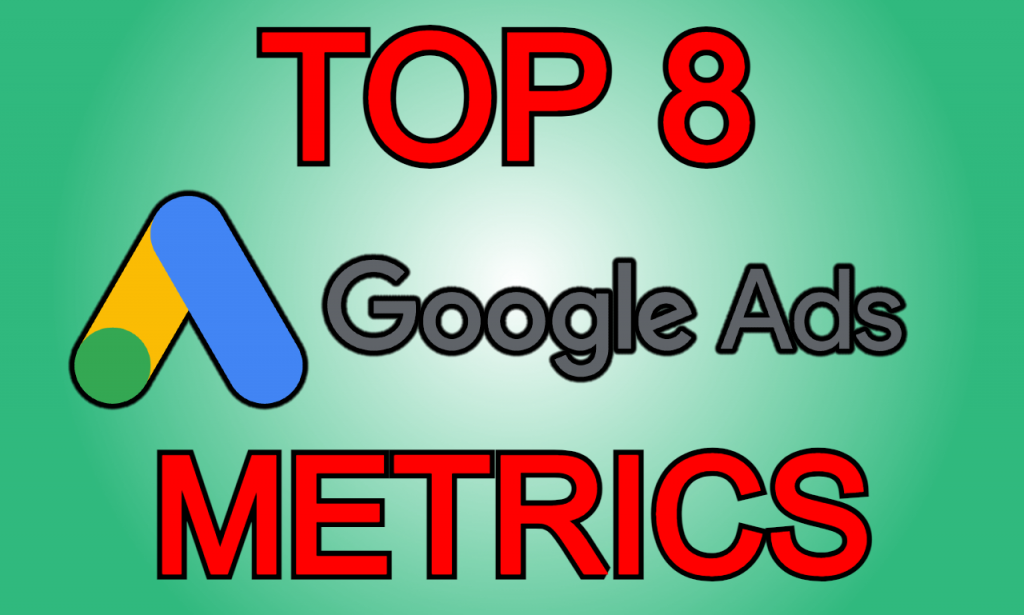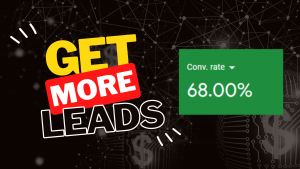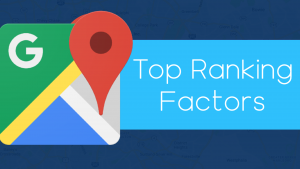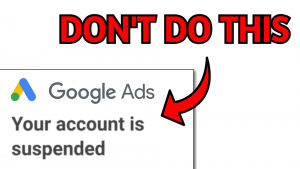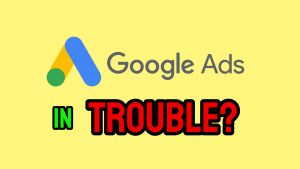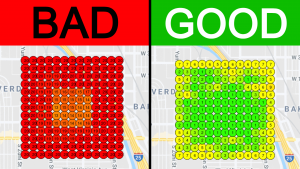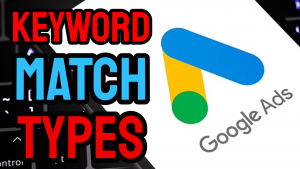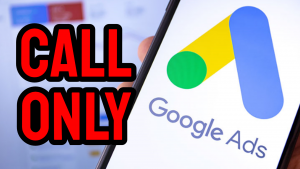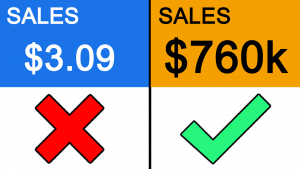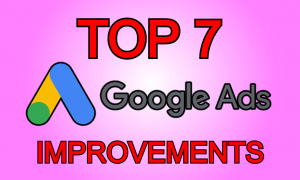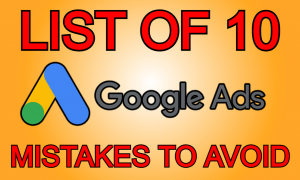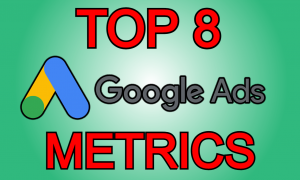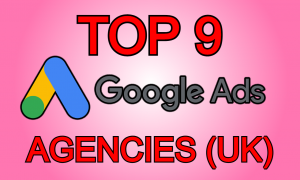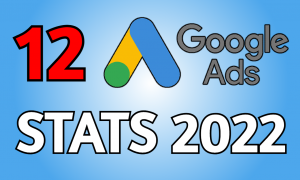With over $60 billion in advertising revenue projected for 2022, Google Ads is currently the largest PPC marketing platform. If you are currently using Google Ads, you need to know how to measure the performance of your campaigns. Here are the Top 8 Google Ads Metrics For Success!
As it contains so much analytical data, it’s understandable that inexperienced marketers could be perplexed.
In this post, we’ll go through the most critical metrics you should be following on your journey to Google Ads success.
Monitoring and Evaluating Google Ads
You know as a savvy digital marketer that you can’t just set up ads and forget about them. You certainly can, but only if you want to waste money. Ads on Google must be tracked, assessed, and optimised. They must be examined on a regular basis.
Most advertisers have different ideas about how to keep their ads in good shape. Some experts advise waiting until they’ve had enough time to provide you with useful information before touching them. Others advise making minor adjustments to bids, keywords, and ad wording on a regular basis. Others advise setting up rules and automation so you don’t have to access your account as much as possible.
Which Google Ads Metrics Are Most Important?
-
Return on Advertising Spend (ROAS)
- Cost Per Conversion (CPC)
- Cost Per Action / Acquisition (CPA)
-
Conversion Rate (%)
-
Click-Through Rate (CTR)
-
Cost Per Click (CPC)
-
Quality Score (/10)
-
Impression Share (%)
Let’s break these down into more detail…
Return on Advertising Spend (ROAS)
The term ‘return on advertising spend’ means: how much money did you spend on advertising and how much money did you earn back? Any ad campaign’s ultimate statistic is return on investment (ROI). This is the metric to use when a CEO asks, “How are the advertising doing?”.
How To Calculate ROAS
ROAS = Total $ Spent on Ads / Total $ Received from Ads
You must maintain track of your transactions and sales, as well as where these leads came from, in order to calculate an accurate ROAS number.
Although it appears to be straightforward, there are numerous things to consider. You may have a long buying cycle and have acquired leads via advertisements, but they are at the top of the funnel and are unlikely to pay you any money. Perhaps someone first came to your site through adverts, but then made a purchase after responding to a social media post that directed them to your site. Should you credit that money to ads or visits from social media sites? These are the choices that your team must make.
What Is A Good ROAS?
More than a 2x ROAS is good, but a 7x ROAS is desirable for experts in the field.
Comparing your return on ads to the return you see on other channels is the greatest benchmark. If it’s much lower, it either means your account needs some help or it’s not the best channel for you. Alternatively, if you see much higher returns on ads, keep investing!
Cost Per Conversion
The amount you pay on each desired action is referred to as the cost per conversion.
This could be the most crucial metric for a specific ad campaign. A conversion can, of course, take many various shapes. A purchase, form submit, or email signup can be a conversion for you. The cost per conversion indicates how much you are paying for the desired action. This measure is critical when it comes to pay-per-click advertisements.
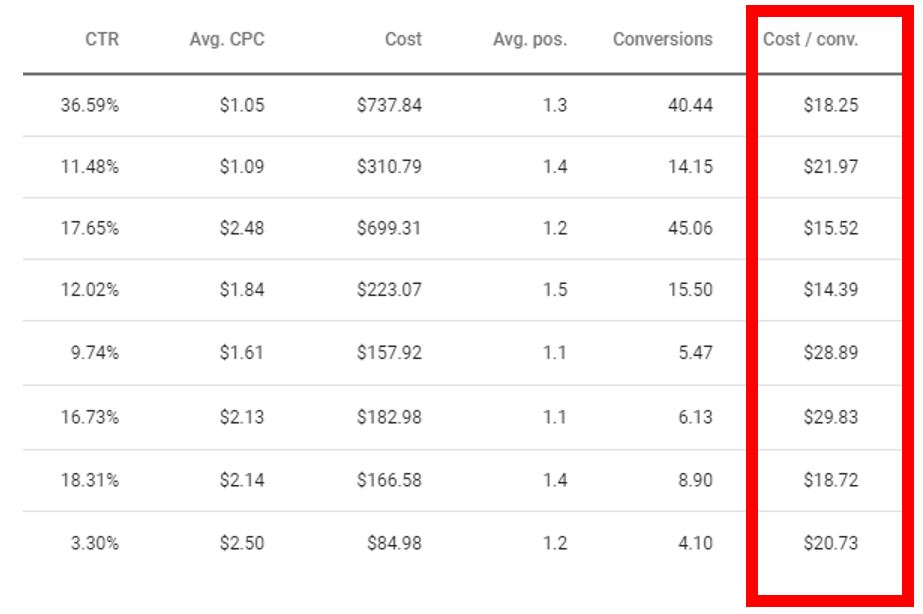
Image from Search Engine Journal
How To Calculate Cost Per Conversion
Cost Per Conversion = Total $ Spent on Ads / Total Number of Conversions From Ad
What Is A Good Cost Per Conversion?
It’s not always simple to know, as it varies depending on the industry and specific services you offer. Consider the following two examples:
Company A uses Google AdWords to direct consumers to a landing page with an email signup as the only request. They charge $50 for each conversion.
Company B uses Google AdWords to direct consumers to a landing page with a $500 product for sale. They charge $250 for each conversion.
Although Company A has a lower cost per conversion, Company B’s campaign is likely to have a $250 ROI. Comparing your cost per conversion in ads to other marketing channels might be a better benchmark. Getting an email address with advertisements may cost $50, but it’s worth it. It may cost $50 to obtain an email address with advertisements, but it may cost $1000 to send someone to a trade exhibition where they receive 15 dollars.
Cost Per Action / Acquisition (CPA)
It’s basically the same as CPC in every way, except it tracks a specific set of actions on your advertisement and website.
Conversion Rate (%)
The conversion rate is the percentage of users who complete the targeted activity after clicking on a link.
Conversion rates provide valuable information about your most effective ad copy, keywords, and landing sites. This metric should provide you with the following information:
- If your landing pages are well-designed,
- If you’re utilising the appropriate keywords, you’ll be fine.
- If you’re aiming for the right demographic
When the conversion rate is low, most people consider the landing page first. However, it’s possible that the problem is due to poor keyword selection or targeting. Make sure you’re going for the right folks and using negative keywords to prevent irrelevant clicks.
One thing the conversion rate does not reveal is the quality of the conversion. As a result, any successful advertising campaign necessitates open lines of communication between ad managers and sales representatives.
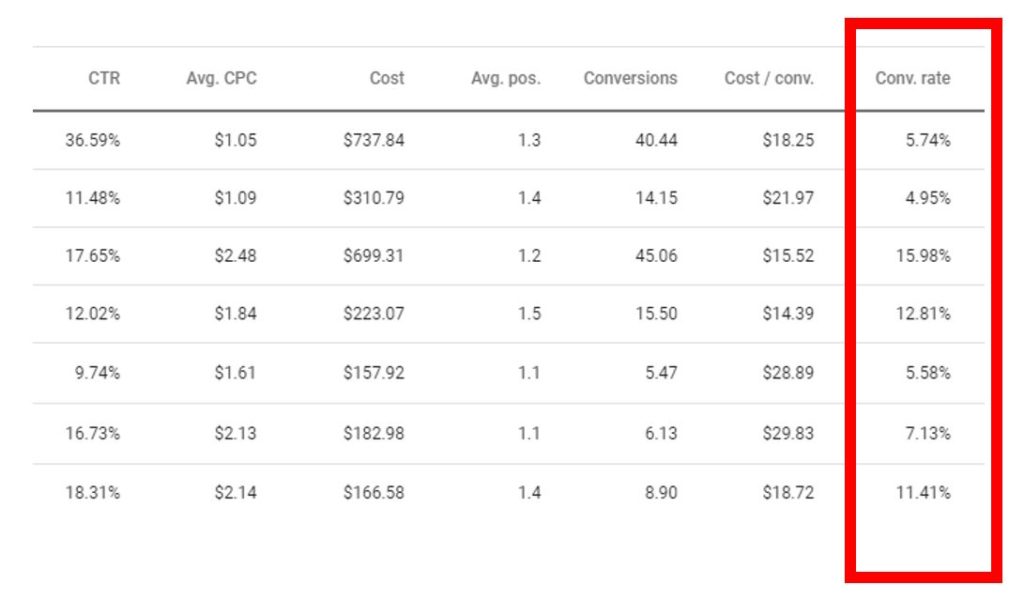
Image from Search Engine Journal
How To Calculate Conversion Rate (%)
Conversion Rate = (Total Number of Conversions / Total Number of Ad Interactions) X 100
What Is A Good Conversion Rate (%)?
According to conventional wisdom, a good conversion rate is between 2% and 5%. Conversions, on the other hand, can signify various things to different businesses. A page asking for an email address will almost certainly have a higher conversion rate than a page asking for a $1,000 gift.
Click-Through Rate (CTR)
The Click-Through Rate indicates how many people saw your ad and clicked on it. It’s a crucial measure to monitor, but it’s not as simple as it seems. You desire a high CTR, yet you only pay for clicks when using Google Ads. You may observe a reduced CTR if you utilise language in your adverts that filters away unqualified clicks. Consider the following scenario:
Company A undertakes a direct-to-consumer ad campaign in order to boost shoe sales. They have a page optimised for blue shoes with green laces and target “blue shoes with green laces” keywords.
Company B is running a campaign to break into a new market with a new product. They target “beef jerky” keywords, yet they’re offering a beef jerky alternative such as Bacon Jerky, which is a different product altogether.
Company A is conducting a safe campaign, whereas Company B is attempting to break into a new market and place their ad in front of people who aren’t necessarily seeking for it. So it’s fine if CTR isn’t extremely high. However, if an ad’s CTR falls too low, its quality score may suffer, so keep an eye on it and make sure your advertisements are still relevant to the keywords you’re targeting.
How To Calculate Click-Through Rate (CTR)
CTR (%) = (Total Number of Clicks / Total Number of Ad Impressions) X 100
What Is A Good CTR (%)?
Wordstream has an amazing article on average CTRs per industry. In general, somewhere between 4% and 8% is the benchmark you should aim for at least.
Cost Per Click (CPC)
The cost per click is the amount you spend for each click (pretty self-explanatory). This is an intriguing metric, because many people believe there isn’t anything that can be done to modify it. Campaigns that are well-optimized, on the other hand, should result in a lower CPC over time. Over the course of a year, you should expect your CPC to drop by about 10%.
How To Calculate Cost Per Click (CPC)
Cost Per Click = Total $ Spent on Ads / Total Number of Clicks From Ad
What Is A Good CPC?
The same resource from Wordstream has an average CPC by industry. This is a fantastic starting point, but keep a watch on the patterns over time.
Quality Score (/10)
The quality score of your keywords is an indicator of their quality. It’s based on ad relevancy, CTR, and landing page experience, and it’s scored on a scale of 1 to 10. Your ad’s quality score has an impact on where it appears in search results and when / if it appears at all.
You can find an ad’s quality score by adding it to your Google Ads dashboard as a column.
You should continuously be monitoring quality scores, rewriting ad copy, and ensuring that users have a positive landing page experience.
How To Calculate Quality Score (/10)
Only Google can calculate and confirm the exact quality score of a specific ad, however you can increase your chances of getting a better quality score by increasing Ad copy relevance, Landing page relevance and keywords relevance in relation to the ad copy and landing page.
What Is A Good Quality Score?
Your goal should be to achieve a quality score of 7-10. If you have a score of less than 7, your adverts may not appear!
Impression Share (%)
The impression share tells you how frequently your adverts appear relative to how frequently they could have appeared. If your ad isn’t appearing, it could be due to rank (Google prioritises advertisements it thinks searchers would click) or budget (yours is limited). You want your ad to appear in every setting conceivable.
Knowing your impression share is useful, but understanding why an ad didn’t show is even more so. If it’s because of your rank, you need to rectify it right away. If it’s because of a budget constraint, that suggests there’s a chance.
Impression Share, Lost Impression Share Due to Budget, and Lost Impression Share Due to Rank can all be found by adding columns to the Google Ads Dashboard.
How To Calculate Impression Share (%)
Impression Share = (Total Number of Impressions / Total Number of Eligible Impressions) X 100
What Is A Good Impression Share (%)?
If your impression share is less than 70-80%, you should investigate where you’re falling short. There isn’t much of a benchmark if it’s due to budget constraints. Sometimes our resources are simply insufficient. A 20-30% loss in impression share due to rank is a significant issue that must be addressed.
Now go follow those metrics and just tell your employer about the positive ones! (I’m joking… Or am I?)
How Savvy Digital Can Help!
If you would like an easy route to analyse your Google Ads campaigns, book in a FREE Google Ads audit today with our team, in which we will bring to your attention any issues and concerns we see with your existing setup and suggest improvements that can enhance your advertising.

